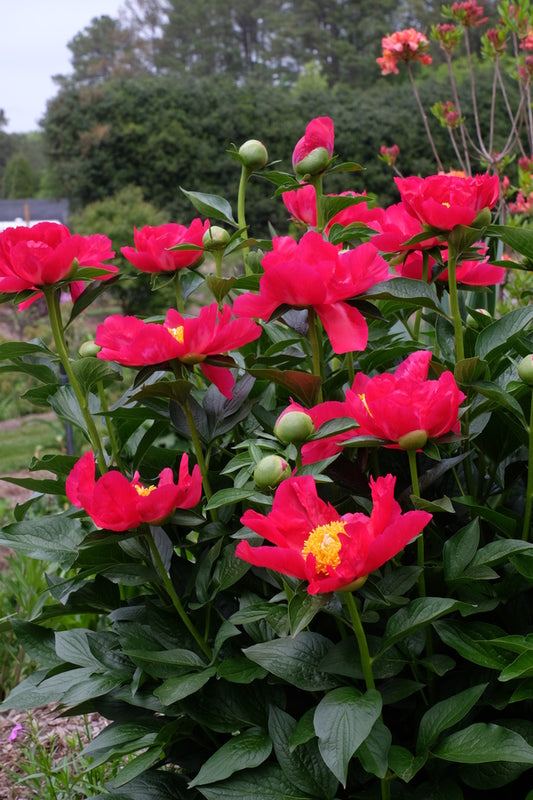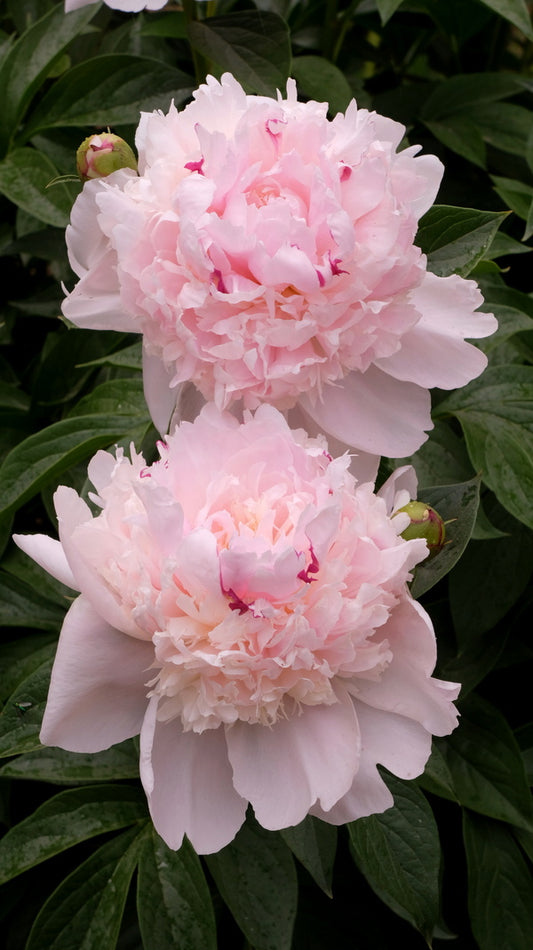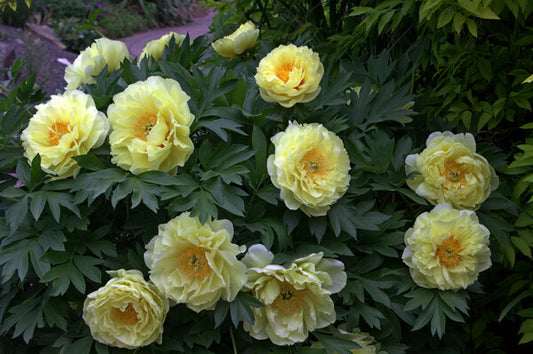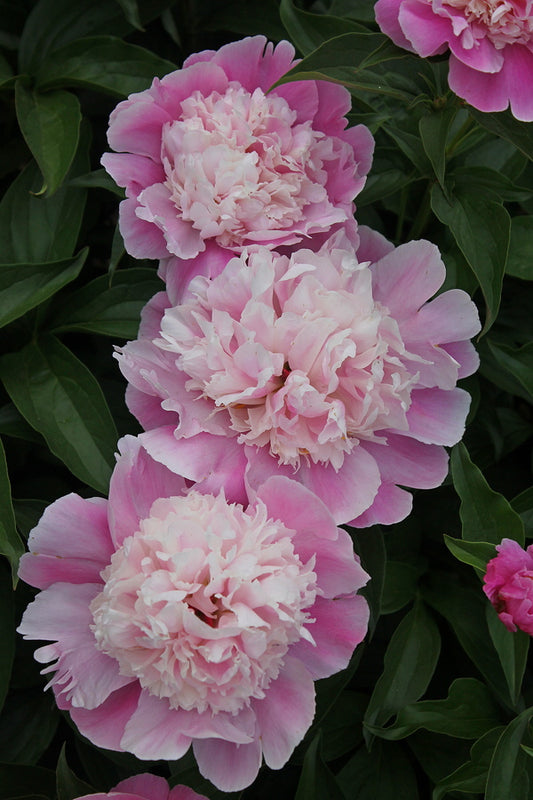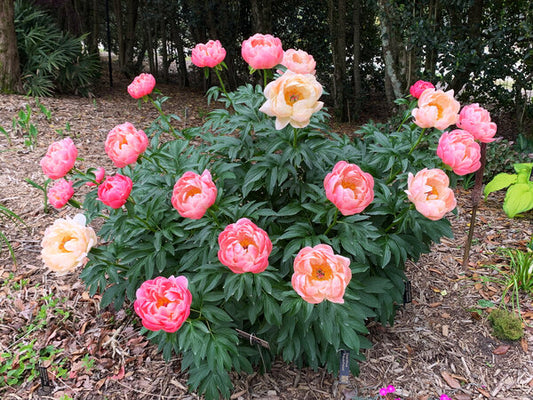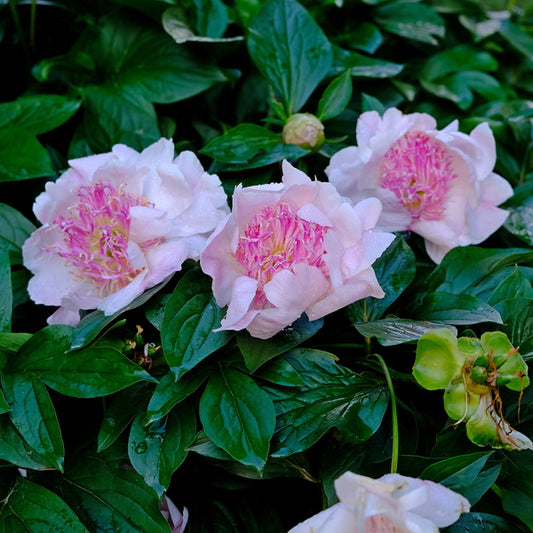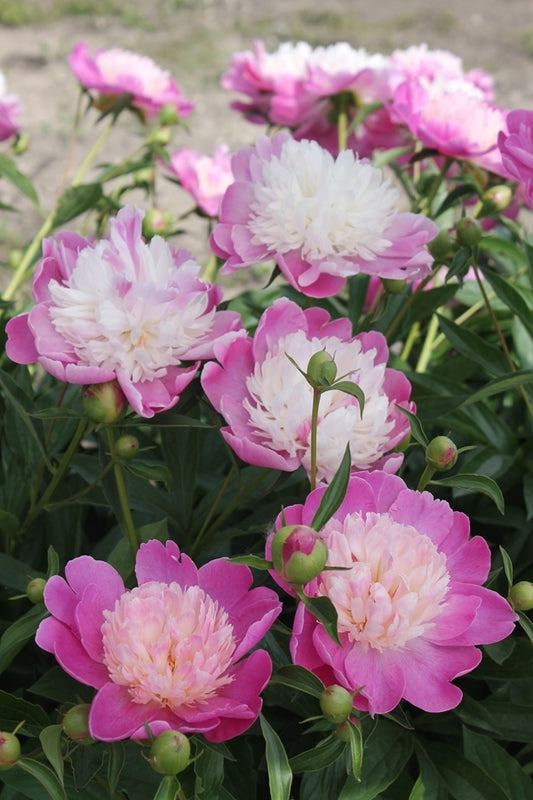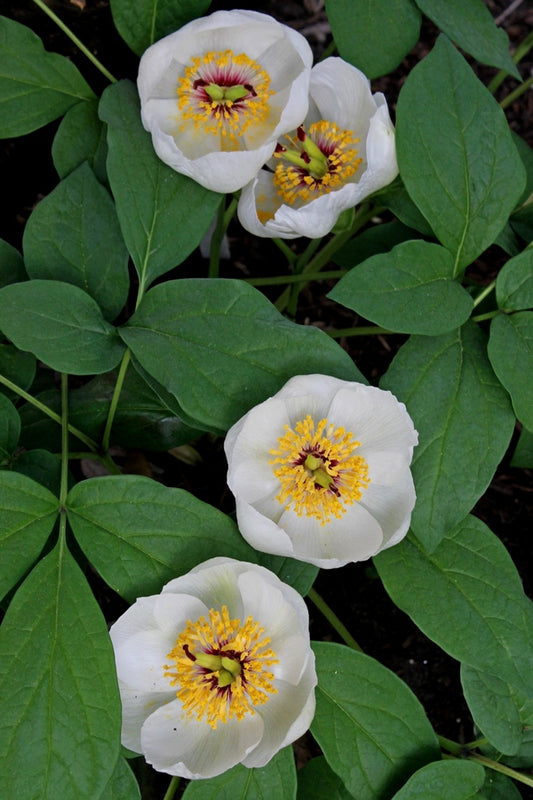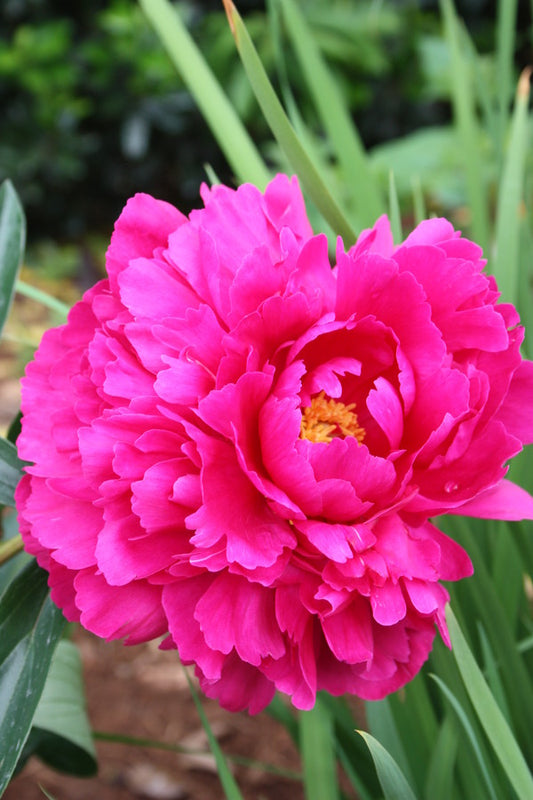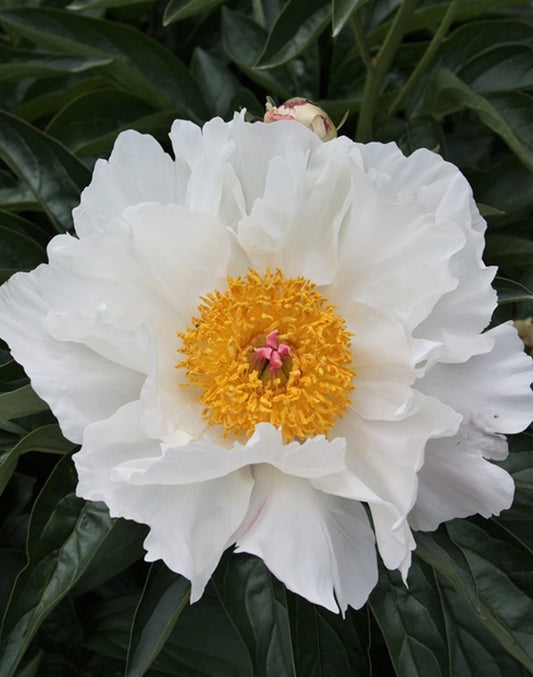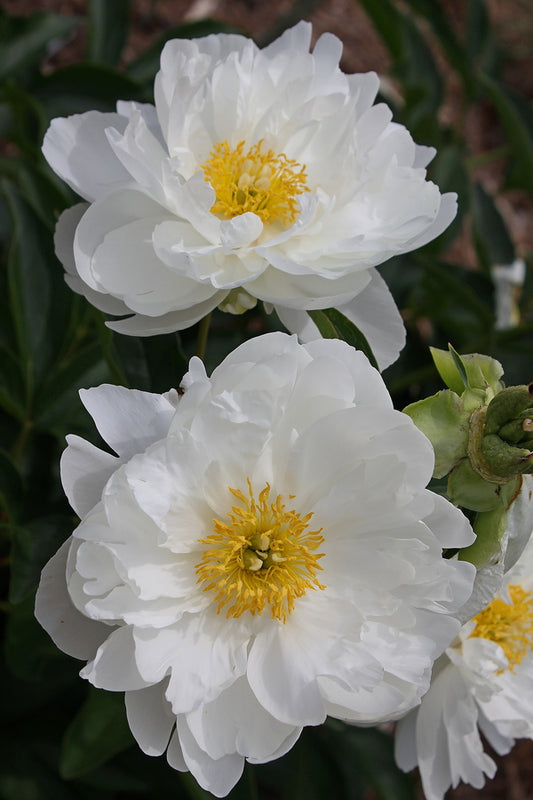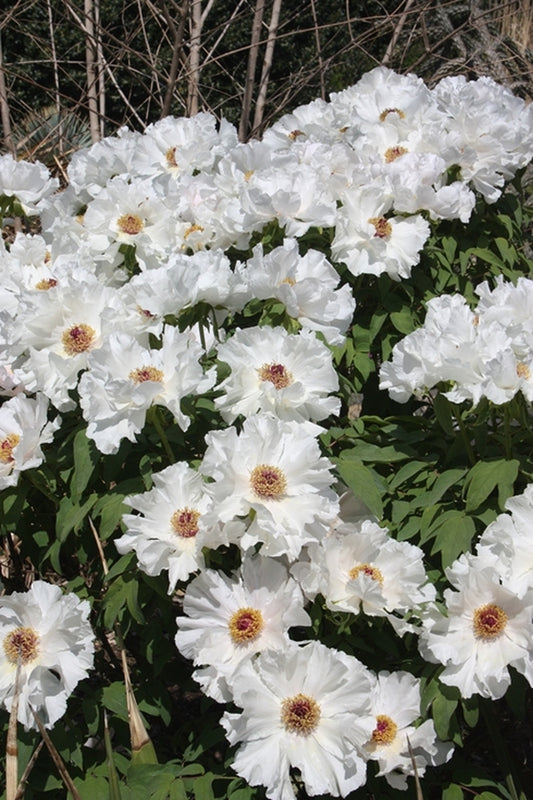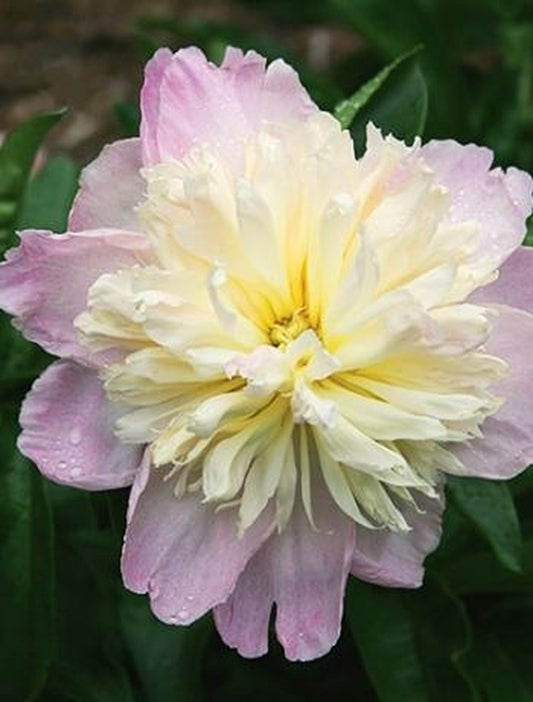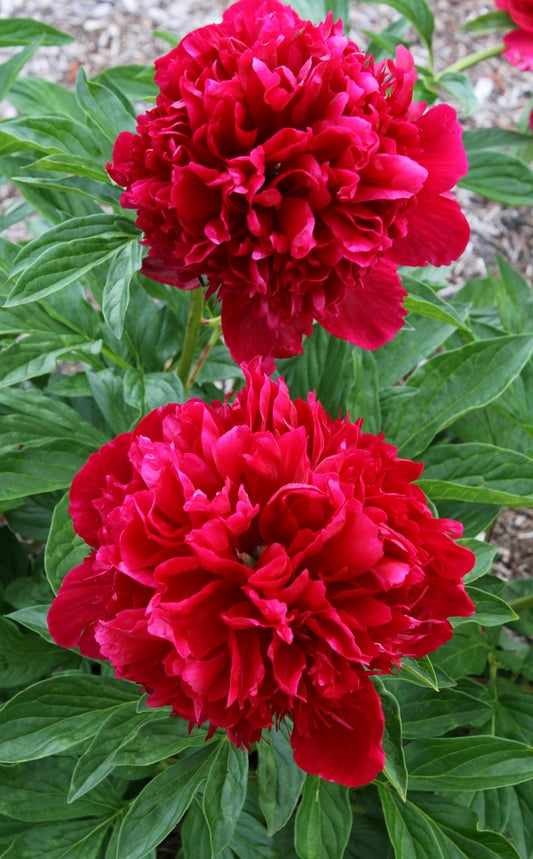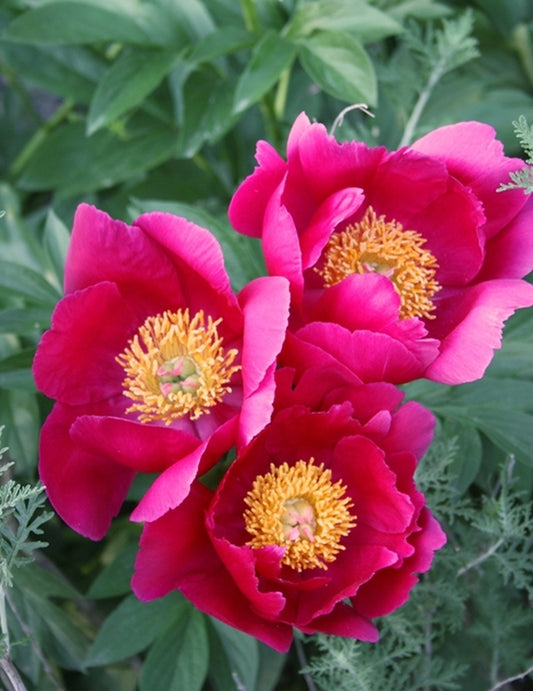Peony growers guide with tips for planting and growing peonies is at the bottom of the page. Our trials for heat-tolerant peonies for the southern US have provided some amazing results and provided us with a great collection of best heat tolerant peony plants. See how to grow peonies in the south.
-
Paeonia 'America'
Item #: 15047
Zones: 4a to 8b
Dormancy: Winter
Height: 30" tall
Culture: Sun
Origin: Hybrid
Pot Size: 3 qt. (2.8 L)
Regular price $34.00Regular priceUnit price per -
Paeonia 'Angel Cheeks'
Item #: 15766
Zones: 3a to 8a
Dormancy: Winter
Height: 28" tall
Culture: Sun
Origin: Hybrid
Pot Size: 3 qt. (2.8 L)
Regular price $35.00Regular priceUnit price per -
Paeonia 'Bartzella'
Item #: 7187
Zones: 4a to 8b, at least
Dormancy: Winter
Height: 36" tall
Culture: Sun to Part Sun
Origin: Hybrid
Pot Size: 1.6 gal. (6 L)
Regular price $75.00Regular priceUnit price per -
Paeonia 'Cora Stubbs'
Item #: 4494
Zones: 3a to 8a
Dormancy: Winter
Height: 32" tall
Culture: Sun
Origin: Hybrid
Pot Size: 3 qt. (2.8 L)
Regular price $35.00Regular priceUnit price per -
Paeonia 'Coral Charm'
Item #: 6186
Zones: 3a to 8a
Dormancy: Winter
Height: 36" tall
Culture: Sun
Origin: Hybrid
Pot Size: 3 qt. (2.8 L)
Regular price $35.00Regular priceUnit price per -
Paeonia 'Do Tell'
Item #: 17030
Zones: 4a to 8b
Dormancy: Winter
Height: 32" tall
Culture: Sun
Origin: Hybrid
Pot Size: 3 qt. (2.8 L)
Regular price $34.00Regular priceUnit price per -
Paeonia 'Gay Paree'
Item #: 10372
Zones: 4a to 8b
Dormancy: Winter
Height: 36" tall
Culture: Sun
Origin: Hybrid
Pot Size: 3 qt. (2.8 L)
Regular price $34.00Regular priceUnit price per -
Paeonia japonica
Item #: 2397
Zones: 5a to 8b
Dormancy: Winter
Height: 18" tall
Culture: Part Sun to Light Shade
Origin: Japan
Pot Size: 3.5" pot (24 fl. oz/0.7 L)
Regular price $50.00Regular priceUnit price per -
Paeonia 'Kansas'
Item #: 5653
Zones: 4a to 8b
Dormancy: Winter
Height: 36" tall
Culture: Sun
Origin: Hybrid
Pot Size: 3 qt. (2.8 L)
Regular price $35.00Regular priceUnit price per -
Paeonia 'Krinkled White'
Item #: 6827
Zones: 4a to 8b
Dormancy: Winter
Height: 24" tall
Culture: Sun
Origin: Hybrid
Pot Size: 3 qt. (2.8 L)
Regular price $35.00Regular priceUnit price per -
Paeonia 'Miss America'
Item #: 10715
Zones: 4a to 8b
Dormancy: Winter
Height: 36" tall
Culture: Sun
Origin: Hybrid
Pot Size: 3 qt. (2.8 L)
Regular price $35.00Regular priceUnit price per -
Paeonia ostii 'Feng Dan Bai'
Item #: 2527
Zones: 4a to 8b, at least
Dormancy: Winter
Height: 60" tall
Culture: Sun to Part Sun
Origin: China
Pot Size: 3 qt. (2.8 L)
Regular price $75.00Regular priceUnit price per -
Paeonia 'Raspberry Sundae'
Item #: 8973
Zones: 4a to 8b
Dormancy: Winter
Height: 30" tall
Culture: Sun
Origin: Hybrid
Pot Size: 3 qt. (2.8 L)
Regular price $35.00Regular priceUnit price per -
Paeonia 'Red Charm'
Item #: 6392
Zones: 4a to 8b, possibly colder
Dormancy: Winter
Height: 36" tall
Culture: Sun
Origin: Hybrid
Pot Size: 3 qt. (2.8 L)
Regular price $35.00Regular priceUnit price per -
Paeonia 'Scarlet O'Hara'
Item #: 5652
Zones: 4a to 8b
Dormancy: Winter
Height: 36" tall
Culture: Sun
Origin: Hybrid
Pot Size: 3 qt. (2.8 L)
Regular price $35.00Regular priceUnit price per
More Information About Paeonia
How to Grow Peonies:
Peony flowers are easy to care for...tough and adaptable. To maximize their growth and flowering potential, just remember...
- Most peonies grow best in full sun but peony flowers will last longer if they receive some afternoon shade. Tree peonies prefer a little afternoon shade and Japanese peonies need a dappled shady spot
- Peonies prefer well-drained soil. Water-logged soil will rot them
- Peonies prefer even and ample moisture during the growing season
- Peonies prefer compost-rich soil, deep and amended with compost with a pH near neutral. No need to fertilize much, and when you do, stick to the organic stuff like compost
- Don't over-mulch your peony. A light winter covering is good, but brush it away in early spring to give those buds some air
- You can plant a peony in fall or spring, but fall planted peonies will establish faster and provide more flowers sooner
- If planting a bare-root peony, position the root so that the eyes (buds) are 1.5-2 inches below the soil (a little deeper if you live in a cold climate like Zone 2 or Zone 3)
- Peony blooms are heavy and the flowers may need staking to keep them from falling over. Use bamboo stakes or small wire cages. Itoh hybrids and tree peonies have little need for staking
- Ants on your peony flower? Don't worry, they are protecting the plant from other bugs, so do not spray them. Live and let live
- Peony Cut Flowers? Cut a long stem when the flower bud is just about to open. The bloom will last about a week in a vase
The Southern Gardener's Peony Guide:
Peony plants are great flowering perennials that gardeners from the northern states know well. In the south, we cannot grow the large variety of lactiflora peonies that you can in the north, but we can grow a few special lactifloras plus the Tree peonies, Itoh hybrids, and woodland Japanese peonies, so we cannot complain too much...we have plenty of peonies for sale.
Peonies are long-lived hardy perennials with huge 5-10 inch wide flowers that come in a wide range of colors from the traditional white peony, pink peony and red peony to the giant-flowered yellow peony (Bartzella) that will leave you drooling. No matter the color, peonies attract butterflies. They are great deer-resistant, pass-along plants...after a few years, your clump will be large enough to divide and share with friends.
Our trials for heat-tolerant peonies for the southern US have provided some amazing results and provided us with a great collection of heat tolerant peony plants for sale. Not only are some of the wild peony species proving to be well-adapted, but several of the peony cultivars, even those with Paeonia lactiflora bloodlines, are doing amazingly well, as are the fabulous itoh peony hybrids (herbaceous peonies x tree peonies - read more about them below).
We also carry the charming woodland peony species (aka Japanese Peonies, Paeonia japonica and Paeonia obovata) for those who want peonies for shady spots. We will continue to expand our listing of peonies for sale with new plants from our trials. We only sell large size peonies, in active growth and we start with large peony rhizomes containing 3-5 eyes. Compare that to the paltry 1-2 eyes on the dried up bare root peonies that our competitors sell.
Peony types:
Itoh Peony
Itoh Peonies (Traditional Peony x Tree Peony) have become very popular in the last few years, although they were first created in the 1940's (by Toichi Itoh, a Japanese peony breeder) and were not available to gardeners until the mid-1970's. They combine the cold hardiness and flower power of the standard herbaceous peony with the bright colors and large flower size of the tree peony.
The tree peony parent contributes some really fantastic flower colors like the incredible yellow peony 'Bartzella', which always sells out for us. Whenever our customers see the giant yellow flowers of Bartzella peony in our Raleigh garden they run to the greenhouse and grab as many as they can for their own garden.
Also called Intersectional peonies, they come in a wide variety of colors and have become favorites now that breeders have expanded the selections and nurserymen have perfected the propagation and growing of these gems.
Growing itoh peonies is a lot like the traditional herbaceous peony...rich soil, full sun, do not over water in winter. In the fall cut off the dead foliage, but leave the stems at about 1.5' tall. Then when the buds break in spring, you can cut back the stems to the topmost bud. Itoh peonies prefer sweet soil over acidic so if you live in an area like Raleigh that traditionally has acid soil, perform a soil test and add some lime if needed.
Japanese Peony
When we talk about the Japanese Peony here at Plant Delights, we mean P. japonica and P. obovata, the species peonies that are native to northern Japan and prefer shaded woodland conditions. This is not to be confused with the Japanese Peony flower form...one of the six peony flower forms of lactiflora peonies (Single, Japanese, Anemone, Semi-Double, Double, Bomb-Double), or the Japanese Tree Peony, which is a group of tree peonies hybridized in Japan.
Now that we have cleared that up, let's talk about how to grow a real Japanese Peony. Part shade or morning sun followed by shade, and rich woodland soil that gets regular water and is well drained.
And why grow a Japanese peony? Because it provides garden interest in both spring and fall. The large single white (P. japonica) or pink (P. obovata) flowers contrasted with bright yellow stamens and red stigmas in spring are followed in autumn by seed pods that split open to reveal a stunning bright red interior that supports large blue-black or scarlet-red seeds. In early spring, the new foliage is also novel, emerging with a pink-burgundy color. For those with deer-issues, this is a good plant...quite deer resistant.
Lactiflora Peony / Herbaceous Peony Bush
When most people buy peonies, this is the one they get. Traditional peony cultivars are favorites in the garden with their huge spring flowers in a wide variety of bright colors like pink, yellow, red and white. The familiar herbaceous peony plant grows best in the northern US, but here in the south there are some wonderful heat tolerant lactiflora peony plants for sale. These are typically the early blooming cultivars.
Tree Peony
(Paeonia ostii, P. suffruticosa and others) Tree peonies tend to grow well in the south, but are sometimes hard to find. Ostii peonies grow quickly and produce dozens of flowers when mature...looking like a giant lactiflora peony. Suffruticosa peonies grow very slowly but have gigantic flowers. Near the northern end of their hardiness range, tree peonies may die back to the ground and their stems may stay somewhat herbaceous.
Don't forget to check out our many blog entries about peonies.


